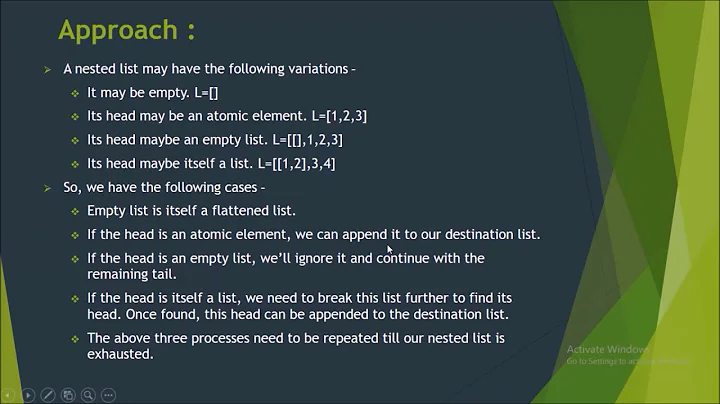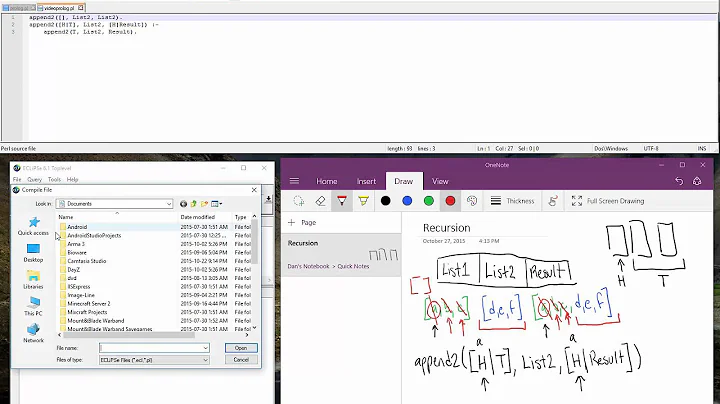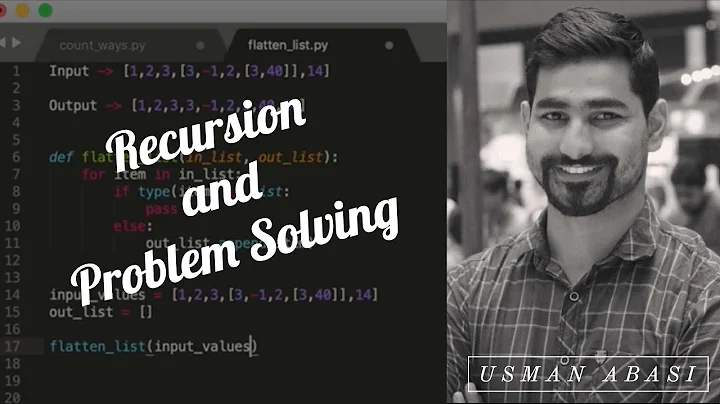Flatten a list in Prolog
Solution 1
The definition of flatten2/2 you've given is busted; it actually behaves like this:
?- flatten2([a, [b,c], [[d],[],[e]]], R).
R = [a, b, c] ;
false.
So, given the case where you've already bound R to [a,b,c,d,e], the failure isn't surprising.
Your definition is throwing away the tail of lists (ListTail) in the 3rd clause - this needs to be tidied up and connected back into the list to return via RetList. Here is a suggestion:
flatten2([], []) :- !.
flatten2([L|Ls], FlatL) :-
!,
flatten2(L, NewL),
flatten2(Ls, NewLs),
append(NewL, NewLs, FlatL).
flatten2(L, [L]).
This one recursively reduces all lists of lists into either single item lists [x], or empty lists [] which it throws away. Then, it accumulates and appends them all into one list again out the output.
Note that, in most Prolog implementations, the empty list [] is an atom and a list, so the call to atom([]) and is_list([]) both evaluate to true; this won't help you throw away empty lists as opposed to character atoms.
Solution 2
You can maintain your lists open-ended, with both a pointer to its start, and an "ending hole ⁄ free pointer" (i.e. logvar) at its end, which you can then instantiate when the end is reached:
flatten2( [], Z, Z):- !. % ---> X
flatten2( [Atom|ListTail], [Atom|X], Z) :- % .
\+is_list(Atom), !, % .
flatten2( ListTail, X, Z). % Y
flatten2( [List|ListTail], X, Z) :- % .
flatten2( List, X, Y), % from X to Y, and then % .
flatten2( ListTail, Y, Z). % from Y to Z % Z --->
You then call it as
flatten2( A, B):- flatten2( A, B, []).
That way there's no need to use reverse anywhere. This technique is known as "difference lists", but it's much easier just to think about it as "open-ended lists" instead.
update: This is much easier coded using the dcg syntax. Since it is unidirectional (the first argument must be fully ground), why not use cuts after all:
flattn([]) --> [], !.
flattn([A|T]) --> {\+is_list(A)}, [A], !, flattn(T).
flattn([A|T]) --> flattn(A), flattn(T).
Testing:
16 ?- phrase(flattn([a,[b,c],[[d],[],[e]]]), [a, b, c, d, e]).
true.
17 ?- phrase(flattn([a,[b,c],[[d],[],[e]]]), R).
R = [a, b, c, d, e].
18 ?- phrase(flattn([a,[b,c],[[d],[],[e]]]), R, [1,2,3]).
R = [a, b, c, d, e, 1, 2, 3].
19 ?- phrase(flattn([a,[b,X],[[d],[],[e]]]), [a, b, c, d, e]).
X = c.
If the definition were fully declarative, the last one should've succeeded also with X=[c] ; X=[[],c] ; ... ; X=[[c]] ; ...; alas, it isn't.
(edit2: simplified both versions, thanks to @mat's comments!)
Solution 3
Without any other predicate, with tail-recursion only.
flatten([[X|S]|T], F) :- flatten([X|[S|T]], F).
flatten([[]|S], F) :- flatten(S, F).
flatten([X|S], [X|T]) :- \+(X = []), \+(X = [_|_]), flatten(S, T).
flatten([], []).
Solution 4
Here's an accumulator based version for completeness:
% flatten/2
flatten(List, Result) :- flatten(List, [], Result).
% auxiliary predicate flatten/3
flatten([], Result, Result).
flatten([Head| Tail], Part, Result) :-
is_list(Head),
!,
flatten(Head, HR),
append(Part, HR, PR),
flatten(Tail, PR, Result).
flatten([Head| Tail], Part, Result) :-
append(Part, [Head], PR),
flatten(Tail, PR, Result).
flatten(X, Part, Result) :-
fail.
Solution 5
Building on if_//3 and list_truth/2, we can implement myflatten/2 as follows:
myflatten(Xs,Ys) :-
phrase(myflatten_aux(Xs),Ys).
myflatten_aux([]) --> [].
myflatten_aux([T|Ts]) -->
if_(neither_nil_nor_cons_t(T), [T], myflatten_aux(T)),
myflatten_aux(Ts).
:- use_module(library(dialect/sicstus/block)).
:- block neither_nil_nor_cons(-).
neither_nil_nor_cons(X) :-
\+nil_or_cons(X).
nil_or_cons([]).
nil_or_cons([_|_]).
neither_nil_nor_cons_t(X,Truth) :-
( nonvar(X)
-> ( neither_nil_nor_cons(X) -> Truth = true
; Truth = false
)
; nonvar(Truth)
-> ( Truth == true -> neither_nil_nor_cons(X)
; Truth == false, nil_or_cons(X)
)
; Truth = true, neither_nil_nor_cons(X)
; Truth = false, nil_or_cons(X)
).
Sample queries (taken from other answers, and comments to answers):
?- myflatten([[4],[[5,6],[7,[8],[9,[10,11]]]]], Xs).
Xs = [4, 5, 6, 7, 8, 9, 10, 11].
?- myflatten([1,[8,3],[3,[5,6],2],8], Xs).
Xs = [1, 8, 3, 3, 5, 6, 2, 8].
?- myflatten([a,[b,c],[],[[[d]]]], Xs).
Xs = [a, b, c, d].
?- myflatten([a,[b,c],[[d],[],[e]]], Xs).
Xs = [a, b, c, d, e].
neither_nil_nor_cons_t and not(nil_or_cons_t) describe have same solutions, but the solution order differs. Consider:
?- myflatten([A,B,C],Xs), A=a,B=b,C=c.
A = a,
B = b,
C = c,
Xs = [a, b, c] ; % does not terminate universally
Related videos on Youtube
ToastyMallows
Been trying to program my way out of a paper bag since 2005. C#, ASP.NET, JavaScript, TypeScript, Python
Updated on April 25, 2022Comments
-
 ToastyMallows about 2 years
ToastyMallows about 2 yearsI've only been working with Prolog for a couple days. I understand some things but this is really confusing me.
I'm suppose to write a function that takes a list and flattens it.
?- flatten([a,[b,c],[[d],[],[e]]],Xs). Xs = [a,b,c,d,e]. % expected resultThe function takes out the inner structures of the list.
This is what I have so far:
flatten2([],[]). flatten2([Atom|ListTail],[Atom|RetList]) :- atom(Atom), flatten2(ListTail,RetList). flatten2([List|ListTail],RetList) :- flatten2(List,RetList).Now, this works when I call:
?- flatten2([a,[b,c],[[d],[],[e]]], R). R = [a,b,c,d,e]. % works as expected!But when I call to see if a list that I input is already flattened, is returns
falseinstead oftrue:?- flatten2([a,[b,c],[[d],[],[e]]], [a,b,c,d,e]). false. % BAD result!Why does it work on one hand, but not the other? I feel like I'm missing something very simple.
-
 mat about 9 yearsWith this specific task, please also consider a more general case: What should
mat about 9 yearsWith this specific task, please also consider a more general case: What should?- flatten([X], Ls).yield? You may think that it "obviously" should yieldLs = [X]. However, you then have the following problem:?- flatten([X], Ls), Ls = [X], X = [a].succeeds, but if we simply exchange the goals by commutativity of conjunction, we get:?- Ls = [X], X = [a], flatten([X], Ls)., or more compactly,?- flatten([[a]], [[a]])., which of course must fail because[[a]]is not a flat list. So, which is it? Fail or succeed? This shows that this is really not a nice relation at all. -
 mat about 9 yearsThis is why I recommend you take a look at
mat about 9 yearsThis is why I recommend you take a look atappend/2. It limits this relation to a more meaningful and often also more practically useful version.
-
-
 ToastyMallows over 12 yearsYou're right it was busted. I don't know why I was getting the right answer before. I understand how your approach works but how does it get rid of empty lists? Also, why is
ToastyMallows over 12 yearsYou're right it was busted. I don't know why I was getting the right answer before. I understand how your approach works but how does it get rid of empty lists? Also, why is[]an atom? -
 Will Ness over 12 years@ToastyMallows it gets rid of
Will Ness over 12 years@ToastyMallows it gets rid of[]s because appending a list and an[]gets you your same list back.[]is both atom and list for historical reasons. Look up "cons" and "nil".[]is what's known in LISP as "nil". -
 Will Ness over 12 yearsI tried
Will Ness over 12 yearsI triedflatten([a,[b,c],[],[[[d]]]],X)call with your code and it didn't work. The atom-handling case seems missing in your version. -
 Will Ness over 12 yearsbut now it produces
Will Ness over 12 yearsbut now it producesX = [a, [c, b], [[[d]]]]. -
FranXh about 10 years(I am new to prolog) What does the ! stand for? I had the same solution, but without ! it does not work
-
 Admin about 10 years
Admin about 10 years!is a special character called a cut in Prolog. It tells the interpreter to cut (ignore) other choices to prevent backtracking. For more information, Learn Prolog Now! has a nice tutorial. -
FK82 over 9 yearsTechnically I like your solution best, but it didn't work for me in SWI-Prolog 6.
-
 Will Ness over 9 yearsusually we try to avoid
Will Ness over 9 yearsusually we try to avoidappend, unless it's O(1), like with e.g. difference lists,app(A-B,B-C,A-C).. -
FK82 over 9 yearsI tried
flatten2([1,[8,3],[3,[5,6],2],8], X).and it returnedfalse. -
FK82 over 9 years@WillNess Yeah, well I'm new to Prolog. :-) I tried to avoid append but couldn't get it to work using lists only.
-
 Will Ness over 9 years@FK82 you're right, I should've used
Will Ness over 9 years@FK82 you're right, I should've usedatomic/1instead ofatom/1. -- fixed it, thanks! -
 Will Ness over 9 yearsnicely done. :) (you didn't do the usual flatten, flatten, append - you tried to make at least one recursive call as a tail call; good). -- BTW, a clause that always
Will Ness over 9 yearsnicely done. :) (you didn't do the usual flatten, flatten, append - you tried to make at least one recursive call as a tail call; good). -- BTW, a clause that alwaysfails can be safely removed altogether - whether it matches a clause's head and immediately fails, or just fails because there was no (any more) matches, doesn't matter: a fail is a fail. -
FK82 over 9 years@WillNess Thank you, noted! :)
-
 false almost 9 yearsThis renames variables element-wise in, say,
false almost 9 yearsThis renames variables element-wise in, say,[[f(X),g(X)]] -
bph almost 9 yearswhat does list( X ) :- var(X) , ! , fail . mean?
-
Nicholas Carey almost 9 years
list(X) :-var(X) , ! , fail.say, "IfXis an unbound variable, X is not a list." The!, fail.bit eliminates the choice point (so it can't follow the predicate's other alternative paths) and fails. With that that guard clause, an unbound variable would unify with[]and succeed. And on backtracking, it would unify (again) with[_|_]and succeed a second time. A true/false check for list-ness should be deterministic. -
 mat over 7 years
mat over 7 years?- flatten(Ls0, Ls).yields: Out of local stack. -
Loic over 7 yearsVariables are not allowed in the first argument, indeed. Otherwise, I believe that the correct solution is computed if it exists.
-
 mat over 7 years
mat over 7 years!//0is a DCG nonterminal, there is no need to wrap it. For example, you can writeflattn([]) --> !.However, you must usephrase/2to portably access a DCG! An implementation is free to choose any expansion method it wants, and indeed need not expand the DCG to explicit differences at all. For example, in some abstract machines, using a different argument order may be a lot more efficient. If you rely on a particular expansion method, it will be increasingly harder to implement such optimizations in future systems. -
 mat over 7 yearsI have upvoted this because the DCG version is the first version of the predicate in this whole thread that I think I have a chance to understand ;-) You can still simplify it though!
mat over 7 yearsI have upvoted this because the DCG version is the first version of the predicate in this whole thread that I think I have a chance to understand ;-) You can still simplify it though! -
 Will Ness about 2 yearsnice idea! too bad it doesn't work for the above mentioned case, but it works for the fully ground lists, so, it's still nice. :)
Will Ness about 2 yearsnice idea! too bad it doesn't work for the above mentioned case, but it works for the fully ground lists, so, it's still nice. :)






